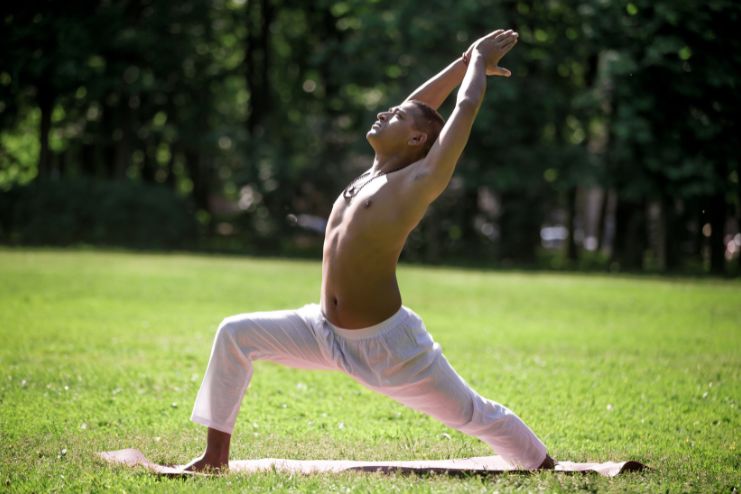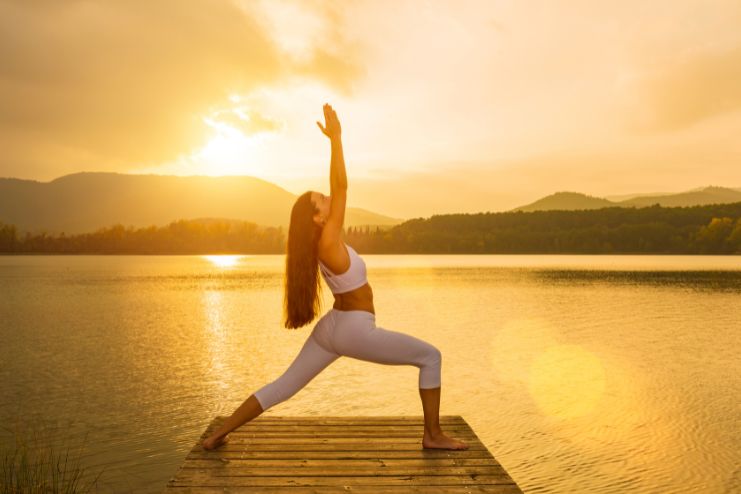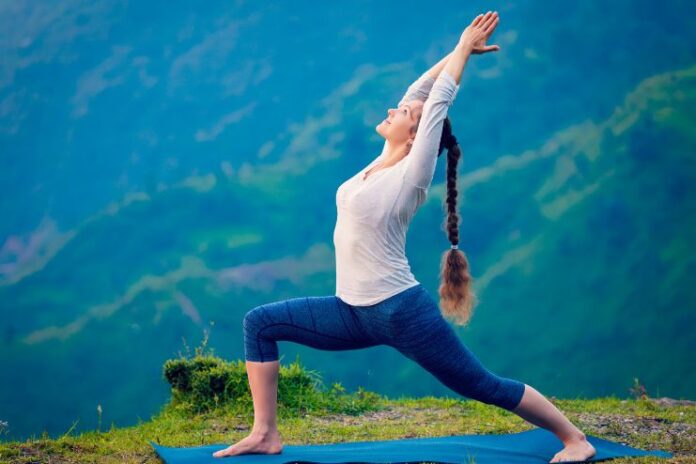Warrior Pose 1, Virabhadrasana 1, is a basic standing yoga pose that symbolizes strength, stability, and concentration. This strong pose, which has its roots in ancient yoga traditions, represents the bravery and tenacity of the warrior Virabhadra, a legendary character in Hindu mythology whom Lord Shiva created. The pose is a mainstay of many yoga practices because it fosters mental resilience while increasing physical endurance.
Virabhadrasana 1 has long been a crucial component of yoga poses to increase flexibility and balance. Hatha and Vinyasa yoga practitioners use it as a transition posture to tone the shoulders, legs, and core. In addition to opening up the chest and hips, this pose promotes deeper breathing and energy flow.
Alignment is essential to benefit fully from Warrior Pose 1. Maintaining proper knee, foot, and spinal alignment improves stability and reduces the risk of injury.
Read More: Why Athletes Swear by Yoga Nidra for Faster Recovery
How to do?
- Stand erect on the ground and hold a steady posture.
- Keep a distance of at least 2-3 feet between the right and the left foot.
- Bring your right foot in front, making a 90-degree angle with the ground.
- Push your left foot back at a 15-degree angle to the ground and align the right foot’s heel with the center of the left foot.
- After you’ve done that, look directly to your right.
- To form the “Namaste” posture, extend your hands over your head, join your palms, and look up at them.
- Hold the position for 30 seconds and repeat it by changing the directions.
Benefits of Virabhadrasana 1 Pose

There are numerous advantages to Warrior 1. You can advance into other poses with the use of this fundamental action. Additionally, it plays a very significant role in many vinyasas, a style of yoga that stresses a fluid transition between poses. Among the advantages of Virabhadrasana 1 are:
Develop Strength: Maintaining this yoga pose requires hip, glute, and leg strength. It also requires upper arm and core strength to stay upright and in the ideal position. This stance is excellent for general strengthening.
Enhance Your Balance: Maintaining Warrior 1 also calls for equilibrium. Feeling a little unsteady when you first try this pose is natural. You’ll get more balance as you practice it and strengthen your legs and core.
Improve Posture: Maintaining an upright posture in Warrior 1 necessitates keeping your head up and shoulders back. It’s an excellent stance to contrast with most people’s daily activity of sitting at desks or slouching over computers or phones.
Get a Good Stretch: Enjoy a stretch that works your chest and hip flexors. In Warrior 1, you’ll also stretch your hamstrings and quadriceps. It stretches and lengthens the spine while also stretching the ankles and calves.
Boost Energy: Warrior 1 is a fantastic revitalizing pose after a long day of desk work. It helps straighten and decompress the spine, often curled and hunched after a long day.enhances circulation, increases joint mobility, and opens the chest to facilitate breathing.
Read More: Wednesday Wellness: Mid-Week Yoga Flow
Modifications and Variations
Modifications can help you prepare for the full Warrior I role if you’re not ready for it yet:
- Props can offer extra assistance for people new to yoga or with balance issues. For example, practicing next to a wall can stabilize the position, particularly when hip alignment is maintained.
- Put your feet farther apart to create a more sturdy posture. As your balance improves, narrow your stance. While practicing balance, you can also hold onto something. Use an exercise bar or a firm chair.
- You can also lessen the bend in the front knee until you are more comfortable in the position.
Having to make adjustments as you develop your yoga practice is quite acceptable.
Warrior 1 can also be modified to increase difficulty.
- Bring your feet closer together to increase difficulty and improve your balance. Place your feet in the manner of someone balancing on a high wire.
- Hold this pose longer each time to increase your strength, attention, and balance. As you maintain the pose, pay close attention to your leg strength and engage the muscles.
Read More: Daily Yoga Poses for Mindfulness and Strength
Precautions

Like every other asana, it is mandatory to go through the list of precautions and prepare to perform the asana accordingly. Before jumping headfirst into it, it is best to be aware of the side effects.
- Always consult a doctor first before doing this posture if you have serious issues with your spine or have just recovered from any chronic disease.
- Maintain a straight line of alignment between your front knee, ankle, and heel. Keep the knee from moving out of the center or ahead of your ankle. Avoid or adjust if you have a hip injury, replacement, hamstring, groin tear, or injury.
- Consider a position variation that uses a chair or the wall for stability if you are prone to losing your balance.
- Try the Anjaneyasana (Low Lunge) foot posture with the back heel raised off the mat if the foot position hurts your back, ankle, or knee. You can also adopt a shorter posture.
- You can adjust the arm positions in the versions that require stretching your arms behind your back or overhead if you have restricted shoulder or chest mobility. Bridge the gap with a towel or strap, then work up to a deeper range of motion.
- Always pay attention to your body and respect its limitations. If a pose hurts or is uncomfortable, ease out of it or adjust it to your needs. It is critical to practice mindfully and appreciate your body’s unique capabilities.
Read More: 10 Best Yoga Mats for Carpets that Don’t Slip
Conclusion
Warrior Pose 1, also known as Virabhadrasana 1, is more than just a standing yoga pose; it is a potent symbol of fortitude, concentration, and resolve. You can develop mental resilience, stability, and flexibility by doing this position daily. If you are new to yoga or an established practitioner looking to advance your practice, learning Warrior Pose 1 can help you achieve mental and physical equilibrium.
When it comes to yoga, consistency is essential. Pay attention to your body, adjust as needed, and approach your practice mindfully and patiently. Remember that each yoga journey is different and that development is made little by little. Try making this pose a part of your everyday practice and see how yoga can change your life!
-
Jun 2018Written by Somapika D
-
May 2025Edited by Ankita
In this Article

















